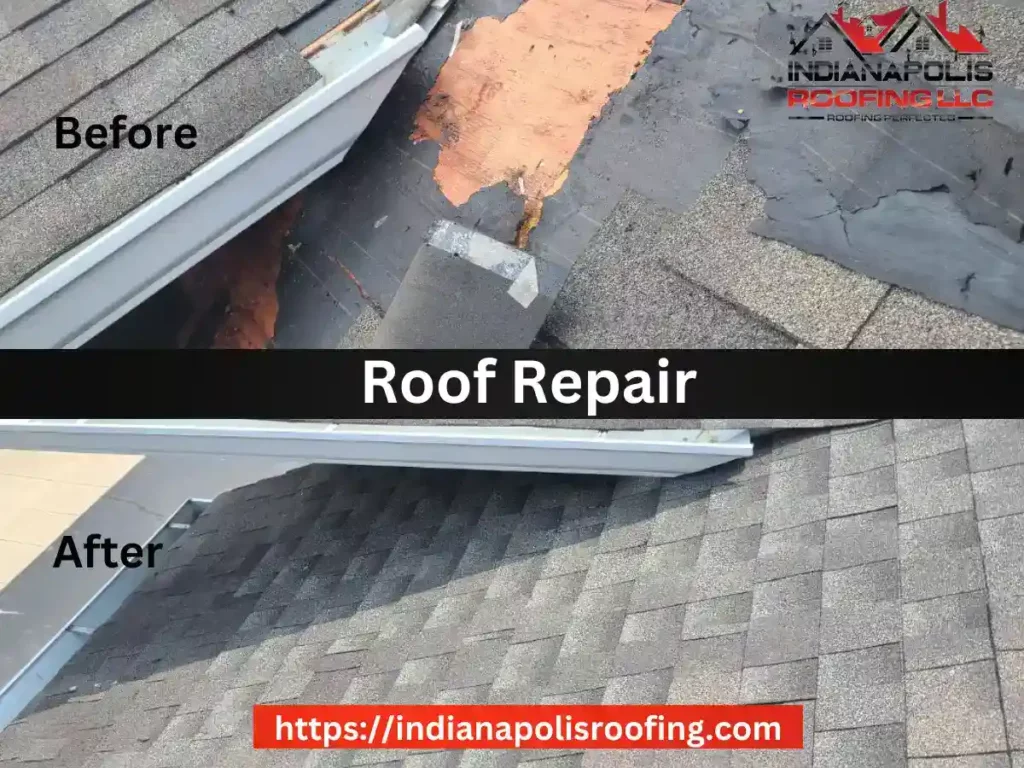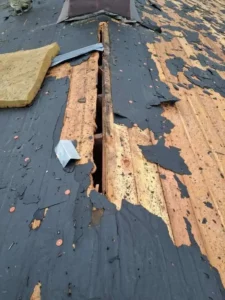For emergency roof repair, quickly assess the damage and secure the area. Then, contact a professional roofer immediately.
Roof emergencies can happen unexpectedly, often during severe weather. Quick action is crucial to minimize damage. Knowing the right steps can save time and money. Begin by assessing the situation safely from the ground. Identify any visible damage or leaks.
Next, secure the area to prevent further issues. Cover exposed areas with a tarp if possible. Contact a professional roofer to inspect and repair the damage. Document everything for insurance purposes. These steps ensure your roof is fixed efficiently, protecting your home from further harm. Emergency roof repair requires prompt and decisive action, so stay prepared and informed.
Table of Contents
ToggleAssess The Damage
Assessing the damage after a storm or any emergency situation is crucial. It helps you understand the extent of the harm and plan the repair process. Follow these steps to ensure you cover everything thoroughly.
Inspect The Roof
Begin by inspecting the roof from the ground with binoculars. Look for missing shingles, cracks, or any visible damage. If possible, safely climb up to get a closer look. Check all areas, including the eaves and valleys.
Use a flashlight to inspect the attic. Look for any signs of water leaks or light coming through the roof. This can help pinpoint where the damage is more severe.

Document The Damage
Thoroughly document the damage for insurance purposes. Take clear photos and videos of all affected areas. Ensure to capture wide shots and close-ups.
Make notes about the type of damage and its location. This will help when discussing repairs with a professional roofer or filing an insurance claim.
Organize your documentation neatly. Use a table if necessary:
| Area | Type of Damage | Notes |
| North Side | Missing Shingles | Approximately 5 shingles |
| Attic | Water Leak | Near chimney |
Keep all this information handy. It will be essential for repair and insurance purposes.
Ensure Safety
Before starting any emergency roof repair, your primary concern should be safety. Roof damage can be dangerous, so take precautions. Follow these steps to ensure everyone stays safe.
Evacuate If Necessary
Evacuate your home if the roof damage is severe. The roof might collapse, causing serious injury. Make sure everyone, including pets, leaves the house quickly.
Once outside, call for professional help immediately. Stay away from the home until it’s safe. Keep a phone handy to contact emergency services if needed.
Use Protective Gear
If you must inspect the roof, use protective gear. Wear a helmet to protect your head from falling debris. Gloves and boots with good grip will keep your hands and feet safe.
Use a safety harness if you need to climb. This will prevent falls and serious injury. Always have someone with you to call for help if needed.
Here is a checklist of protective gear to use:
- Helmet
- Gloves
- Non-slip boots
- Safety harness
Temporary Fixes
When your roof suffers damage, immediate action is crucial. Temporary fixes can help protect your home until professional repair is possible. Here are two essential steps to minimize damage and keep your home safe.
Cover With Tarp
Covering the damaged area with a tarp is a quick solution. Follow these steps to do it right:
- Get a large, durable tarp from a hardware store.
- Ensure the tarp covers the entire damaged area and overlaps by at least 3 feet.
- Secure the tarp with heavy-duty nails or screws. Fasten the edges tightly to prevent wind from lifting it.
- Use sandbags or other heavy objects to weigh down the tarp if needed.
This method protects your roof from rain and debris, keeping your home safe until repairs can be made.
Seal Leaks
Sealing leaks is another critical step in emergency roof repair. Here’s how you can do it:
- Locate the source of the leak inside your home. Use a flashlight if needed.
- Mark the leak’s location with chalk or tape. This helps you find it on the roof.
- Use roofing sealant or cement to cover the leak. Apply a generous amount to ensure full coverage.
- Press a patch of roofing fabric over the sealant for extra protection. Apply another layer of sealant on top of the fabric.
Sealing leaks prevents water damage and keeps your home dry until professional help arrives.
Contact Professionals
Roof damage can be daunting. Calling professionals ensures safety and proper repair. Here’s how to contact reliable experts for emergency roof repair.
Find A Reliable Roofer
First, find a reliable roofer. Check reviews online. Ask friends for recommendations. Ensure they have proper licenses and insurance.
| Steps | Details |
| Check Reviews | Read customer feedback on platforms like Yelp and Google. |
| Ask for Recommendations | Inquire with friends or neighbors who have had roof repairs. |
| Verify Licenses | Ensure the roofer has valid licenses and insurance coverage. |
Get An Estimate
Once you find a roofer, get an estimate for the repair. Request a detailed quote. Compare it with other quotes.
- Contact the roofer and describe the damage.
- Request a written estimate.
- Compare the estimate with other roofers.
Ensure the estimate covers all costs. Look for hidden fees. A clear estimate helps avoid surprises later.
Following these steps will help you find the best professional for your emergency roof repair needs. Always choose a licensed and insured roofer.
Insurance Claims
Filing an insurance claim can be confusing during a roof emergency. Follow these steps to ensure a smooth process and get the help you need.
Review Policy
First, review your homeowner’s insurance policy. Check if it covers roof damage. Look for specifics on what types of damage are included. This might be natural disasters, fallen trees, or other incidents.
Take note of the deductible and coverage limits. Knowing these details will help you understand what costs will be covered. Always keep a copy of your policy handy for quick reference.
File A Claim
Next, contact your insurance provider to file a claim. This can usually be done online or by phone. Provide all necessary information about the damage. Be ready to share photos and any documentation you have.
Keep a record of all communications with the insurer. This includes emails, phone calls, and any documents sent or received. Staying organized will help streamline the process.
Here’s a quick checklist for filing a claim:
- Review your policy details
- Contact your insurance provider
- Provide detailed information about the damage
- Submit photos and documentation
- Keep a record of all communications
Filing an insurance claim doesn’t have to be difficult. By following these steps, you can make the process easier and ensure your roof gets repaired quickly.
Prevent Future Damage
Preventing future damage to your roof is crucial. It saves money and keeps your home safe. Follow these steps to ensure your roof stays in great shape.
Regular Inspections
Regular inspections help spot problems early. Look for missing shingles, cracks, or leaks. Inspect your roof at least twice a year. Here’s a simple inspection checklist:
- Check for loose or missing shingles.
- Look for signs of water damage.
- Inspect the attic for leaks.
- Ensure gutters are clear of debris.
- Check for any sagging areas.
Maintenance Tips
Proper maintenance can extend your roof’s life. Follow these tips to keep your roof in top condition:
- Clean gutters regularly. Remove leaves and debris.
- Trim overhanging branches. Prevents damage from falling branches.
- Seal any cracks. Use a roof sealant to fix small cracks.
- Replace damaged shingles. Don’t wait to fix them.
- Check flashing. Ensure it’s secure and not damaged.
By following these steps, you can prevent future roof damage. Regular inspections and maintenance are key.
Choosing Materials
Picking the right materials for an emergency roof repair is crucial. The materials you choose can affect the durability, cost, and effectiveness of the repair. Below are some key points to consider.
Durable Options
Durable materials ensure your repair lasts a long time. Here are some strong options:
- Metal Sheets: Long-lasting and weather-resistant.
- Asphalt Shingles: Easy to install and widely available.
- Rubber Roofing: Perfect for flat roofs and has a long lifespan.
Choose materials that can withstand harsh weather. This will save you money and effort in the long run.
Cost Considerations
Balancing cost and quality is key in an emergency. Here’s a quick guide:
| Material | Average Cost per Square Foot |
| Metal Sheets | $5 – $12 |
| Asphalt Shingles | $1 – $4 |
| Rubber Roofing | $4 – $8 |
Metal sheets are the most expensive but also the most durable. Asphalt shingles are budget-friendly and reliable. Rubber roofing offers a good balance of cost and durability.
Always consider your budget and the urgency of the repair. Sometimes, spending a bit more upfront saves money later.
Emergency Kit Essentials
Being prepared for a sudden roof emergency saves time and stress. Having the right tools and safety equipment on hand is crucial. This section guides you through the essential items to include in your emergency roof repair kit.
Basic Tools
Every emergency kit should have basic tools for quick repairs. Below is a list of the most essential items:
- Hammer: Useful for securing tarps or shingles.
- Nails: Keep a variety of sizes for different fixes.
- Utility Knife: Handy for cutting materials like tarps.
- Measuring Tape: Ensures precise measurements.
- Roofing Cement: Ideal for sealing leaks temporarily.
Safety Equipment
Safety is the most important part of any roof repair. Always wear proper safety gear to protect yourself. Here is a list of must-have safety items:
- Hard Hat: Protects your head from falling debris.
- Gloves: Prevents cuts and improves grip.
- Safety Glasses: Shields your eyes from dust and particles.
- Non-Slip Boots: Ensures you have good traction on the roof.
- First Aid Kit: Always have one available for emergencies.
Including these items in your emergency kit will help you stay safe and effective during roof repairs.
Conclusion
Taking swift action can save your roof from further damage. Follow these five steps for effective emergency repair. Always prioritize safety and consult a professional for complex issues. With proper care, your roof will stay strong and durable. Implement these tips to protect your home and ensure long-lasting results.






